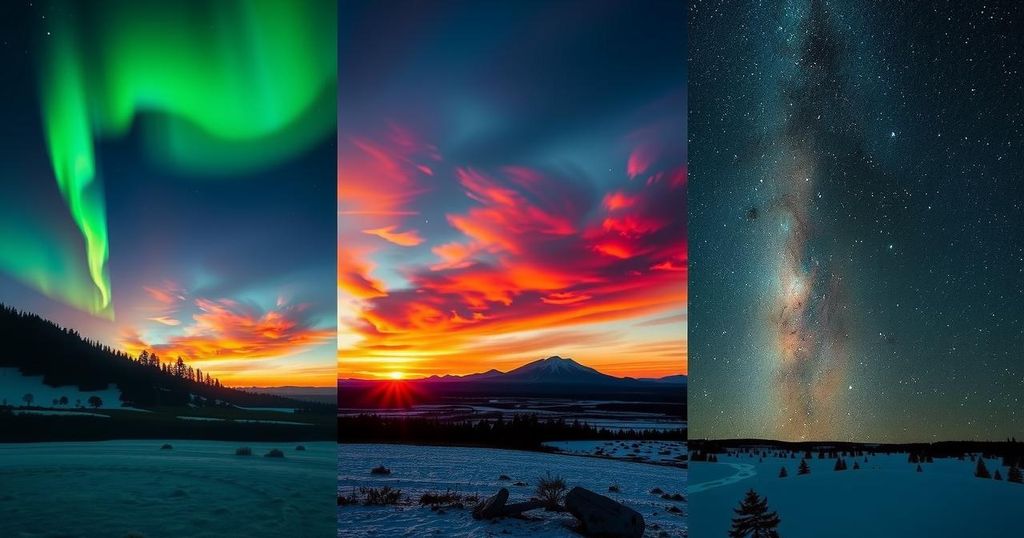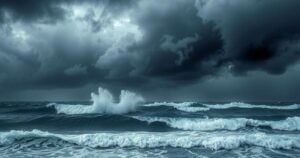Exploring Natural Phenomena: Norway, Venezuela, and Australia

This article discusses three captivating natural phenomena: the Northern Lights in Tromsø, Norway; lightning storms at Lake Maracaibo, Venezuela; and the Morning Glory Cloud in Queensland, Australia. Each event contributes significantly to local tourism, attracting visitors and boosting economies. These unique experiences highlight the planet’s natural beauty and appeal to adventure-seeking travelers globally.
The sky presents numerous captivating natural phenomena that enchant observers. Various destinations worldwide are renowned for their celestial events, which not only offer stunning viewing opportunities but also significantly enrich local tourism economies. Noteworthy examples include the Northern Lights in Norway, lightning storms in Venezuela, and the Morning Glory Cloud in Australia, each attracting travelers eager to experience these unique wonders.
A premier attraction is the Aurora Borealis, or Northern Lights, famous for its vibrant light displays. These displays occur when solar particles collide with the Earth’s atmosphere, creating mesmerizing colors in high-latitude areas. The tourism industry benefiting from this phenomenon is substantial, with estimates suggesting its annual value exceeds $800 million. Countries like Iceland, Sweden, Finland, and Norway—especially Tromsø—are hotspots for witnessing this astonishing natural spectacle.
In Tromsø, clear skies from September to April make it an ideal location for Northern Lights viewing, and its milder climate adds to its accessibility. Nearby Sommarøy Island offers minimal light pollution for an enhanced Aurora experience, and guided tours are available to improve visibility and overall experience of the Northern Lights phenomenon.
Venezuela, though less commonly chosen by travelers, is notable for its distinct lightning displays at Lake Maracaibo, dubbed the world’s lightning capital. This region experiences frequent lightning storms, up to 280 days a year, with an exceptional number of lightning strikes—sometimes over 40,000 per storm. Boat tours from Puerto Concha provide spectacular views of these impressive storms, attracting photographers and storm enthusiasts alike, contributing to Venezuela’s tourism.
Australia’s Morning Glory Cloud, observed in Queensland between September and October, showcases a unique cloud formation caused by warm and cool air interaction. Stretching over 600 miles and moving at speeds exceeding 30 mph, this phenomenon draws glider pilots who aim to skillfully surf its updrafts. This eco-friendly adventure promotes Queensland as a premier destination for both sports and natural wonders, impacting local tourism positively.
The global impact of these natural phenomena on travel and tourism is significant. The Northern Lights, Venezuela’s lightning storms, and the Morning Glory Cloud attract international visitors, boosting local economies and fostering deeper connections with nature. As interest in such events grows, the tourism industries in these destinations are adapting and expanding their infrastructure, ensuring more individuals can experience these natural wonders firsthand. The travel industry’s development fosters appreciation for the planet’s beauty, encouraging exploration of unique global attractions.
In summary, the Northern Lights in Norway, the lightning storms at Lake Maracaibo in Venezuela, and the Morning Glory Cloud in Australia represent extraordinary natural phenomena that captivate travelers. Each destination not only offers unforgettable experiences but also plays a critical role in enhancing local tourism sectors. As appreciation for these natural wonders grows, so too does the incentive for travelers to explore the beauty of our planet.
Original Source: www.travelandtourworld.com






